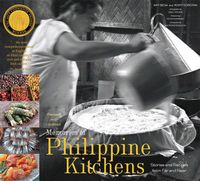Advertisement
Bibingka

By Amy Besa and Romy Dorotan
Published 2006
We have always translated bibingka as rice cake. While that is how most Filipinos will use it, it is not quite accurate. The majority of bibingkas are indeed made of ground rice and water, white sugar, baking powder, or yeast and often coconut milk for added luxury. But cassava bibingka, made with grated yucca, is another classic, well-loved dessert. The word refers not to rice but to a type of baking that requires very high heat at the top with low heat at the bottom, which gives bibingkas their characteristic caramelized tops. Since most people in the rural areas in the Philippines do not have ovens, many local bibingka makers form a makeshift oven. The bibingka is baked in a pan lined with banana leaf over a low fire, covered with a metal sheet with burning bunot [coconut husk], wood, pili shells, or hot coals heaped on top. This method defines the concept of bibingka.

